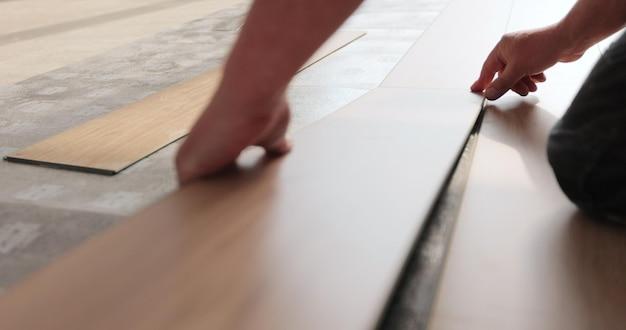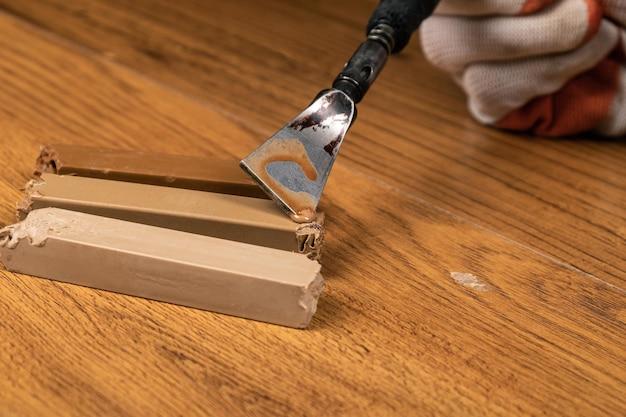Laminate flooring has become a popular choice for homeowners due to its affordability and durability. Whether you’re installing laminate flooring for the first time or looking to fix any issues with your existing floor, finding the right glue is crucial. The type of glue you use can determine the longevity and stability of your flooring. But with so many options available, how do you know which glue is best for laminate flooring?
In this comprehensive guide, we’ll answer all your burning questions about gluing laminate flooring. From discussing the pros and cons of gluing versus nailing down a floating floor to providing solutions for floor movement and lifting issues, we’ve got you covered. We’ll also explore different types of adhesives suitable for laminate flooring and provide tips on preventing floor separation and minimizing bouncing. So, let’s dive in and discover the secrets to a perfectly installed and well-maintained laminate floor.
What Kind of Glue to Use for Laminate Flooring
Laminate flooring is a fantastic option that combines affordability, durability, and easy installation. But when it comes to installation, one question often arises: What kind of glue should you use for laminate flooring? Well, fear not, my savvy renovators, because I’m here to give you the lowdown on the best glues for laminate flooring like a true DIY guru.
The Glue That Holds It All Together
Whether you’re installing laminate flooring for the first time or repairing a few pesky spots, using the right glue is vital. It not only ensures a strong bond but also prevents those annoying creaks and wobbles that can plague an otherwise perfect floor. So, let’s dive into the magical world of laminate flooring glues, shall we?
1. PVA Glue – The All-Around Champion
If you’re looking for a versatile and reliable glue for your laminate flooring, look no further than PVA (Polyvinyl Acetate). This glue is like the Swiss Army knife of adhesives. Not only does it provide a strong bond, but it also has a long working time, allowing you to adjust the planks if needed. Plus, it’s water-resistant, ensuring your laminate flooring stays intact when life throws unexpected spills your way.
2. Polyurethane Glue – The Waterproof Wonder
When it comes to areas prone to moisture, like bathrooms or kitchens, using a waterproof glue is essential. Enter polyurethane glue, a superstar adhesive for laminate flooring in damp environments. Its moisture-resistant properties, combined with its incredible bond strength, ensure that your laminate planks stay firmly in place, no matter what spills or splashes may occur.
3. Cyanoacrylate Glue – The Quick-Fix Master
Picture this: you’ve just finished installing your beautiful laminate flooring, but oops! There’s a tiny gap between two planks that’s spoiling the perfection. Fear not, my friend, for cyanoacrylate glue, also known as super glue, is here to save the day. This fast-drying adhesive will seamlessly fill those gaps, ensuring your laminate flooring looks flawless, even to the most discerning eye.
4. Epoxy Resin – The Heavy-Duty Hero
For areas that receive heavy foot traffic or furniture that may cause extra stress on your laminate flooring, epoxy resin is the ultimate hero. This ultra-strong adhesive creates an unbreakable bond that can withstand the test of time. So go ahead, dance like nobody’s watching or rearrange your furniture to your heart’s content – your laminate floor, partnered with epoxy resin, can handle it all.
In the exciting world of laminate flooring installation, the right glue can make all the difference. From versatile PVA glue to moisture-resistant polyurethane glue, and from quick-fix cyanoacrylate glue to heavy-duty epoxy resin, each type has its own superpowers that ensure your laminate flooring stays beautiful and sturdy. So, my DIY enthusiasts, armed with this knowledge and a dose of humor, go forth and conquer the world of laminate flooring with confidence in 2023 and beyond!
FAQ: What Kind Of Glue Should I Use For Laminate Flooring
When it comes to laminate flooring, choosing the right glue is essential for ensuring a long-lasting and sturdy installation. We’ve gathered some frequently asked questions to help guide you through the adhesive selection process.
Is It Best To Glue Laminate Flooring
In most cases, gluing laminate flooring is not necessary. Laminate flooring is designed to be a floating floor, which means it is not attached directly to the subfloor. However, in situations where there is excessive foot traffic or if you are installing in a high-moisture area, using adhesive can provide additional stability and prevent shifting or squeaking.
Can You Nail Down A Floating Floor
No, you should never nail down a floating floor, including laminate flooring. Nails can restrict the natural movement of the floor and cause damage over time. Remember, the key appeal of a floating floor is its ability to expand and contract with temperature and humidity changes.
How Do I Keep My Laminate Floor From Moving After I Install It
To keep your laminate floor from moving after installation, there are a few steps you can take. First, ensure that the subfloor is clean and level. Use an underlayment designed for laminate flooring to provide cushioning and stability. Additionally, you can use transition strips between rooms and apply silicone caulk along the edges to further secure the floor in place.
What To Do If Laminate Floor Is Lifting
If you notice your laminate floor lifting, it is essential to address the issue promptly. The most common cause of lifting is subfloor moisture. Start by identifying and eliminating the source of moisture. Then, allow the floor to dry completely. If the lifting persists, consult a flooring professional who can assess the situation and provide guidance on repair or replacement.
What Keeps Laminate Flooring In Place
Laminate flooring is typically kept in place by the interlocking mechanism of the planks, which holds them together tightly. Additionally, the weight of furniture and properly installed transition strips help keep the floor in place. However, in some cases, using an appropriate flooring adhesive can provide extra stability, especially for areas with heavy foot traffic or specific environmental conditions.
Can You Use Liquid Nails On Laminate Flooring
While Liquid Nails is a popular adhesive, it is not recommended for laminate flooring. Liquid Nails is designed for vertical applications and may not adhere well to the horizontal surface of the floor. Using a dedicated laminate flooring adhesive, specifically formulated for the task, will yield better results and ensure a more secure installation.
Is It Better To Glue Or Float Vinyl Plank Flooring
Vinyl plank flooring, like laminate flooring, is typically installed as a floating floor. Floating installation allows for ease of installation, flexibility, and the ability to change or replace individual planks if needed. Gluing vinyl plank flooring is generally not necessary, as the interlocking system provides sufficient stability. However, if you have specific concerns about movement or moisture, using adhesive can offer additional security.
What Glue Do You Use For Flooring
For laminate flooring, it is recommended to use a dedicated laminate flooring adhesive. These adhesives are specifically formulated to provide a strong bond while allowing for the natural movement of the floor. Look for adhesives labeled as “laminate flooring adhesive” or consult with your flooring manufacturer for their recommended adhesive.
Why Won’t My Laminate Floor Stay Together
If your laminate floor keeps coming apart, it could be due to several factors. Uneven subfloor, poor installation technique or insufficient underlayment can cause gaps between the planks. Additionally, excessive moisture or temperature fluctuations may affect the integrity of the floor. Proper installation, including using a suitable underlayment and following the manufacturer’s guidelines, can help prevent these issues.
Do You Need Wood Glue For Laminate Flooring
No, you do not need to use wood glue for laminate flooring. The interlocking design of laminate flooring planks ensures a secure connection without the need for wood glue. However, if you are installing laminate flooring on stairs or vertical surfaces, it may be necessary to use wood glue to provide additional stability.
Why Is My Laminate Flooring Coming Apart
Laminate flooring may come apart due to several reasons. Poor installation techniques, improper subfloor preparation, or using the wrong type of underlayment can all contribute to this issue. High levels of humidity or moisture can also cause the planks to swell and come apart. It is essential to follow proper installation guidelines and ensure that the subfloor is clean, flat, and dry before installing laminate flooring.
What Type Of Glue Is Used For Laminate Flooring
For laminate flooring, it is recommended to use a premium-quality laminate flooring adhesive. These adhesives are specifically formulated to provide a strong and flexible bond while allowing the floor to expand and contract naturally. Look for adhesives that are water-resistant and designed for laminate flooring installation. Always consult the manufacturer’s instructions for the recommended adhesive to ensure the best results.
Do You Glue A Floating Floor
In general, you do not need to glue a floating floor, including laminate flooring. Floating floors rely on their interlocking mechanism and the weight of furniture to remain in place. However, if you have concerns about movement or if you are installing in a high-traffic area, using an appropriate adhesive can provide additional stability and prevent the floor from shifting or making noise.
Why Does My Laminate Floor Move When I Walk On It
If your laminate floor moves or feels unstable when you walk on it, there may be several reasons behind it. Uneven subfloor, insufficient underlayment, or poor installation technique can contribute to this issue. Additionally, if the floor was not acclimated properly before installation, it may expand or contract, leading to movement. Proper installation techniques, including using an appropriate underlayment and following manufacturer guidelines, can help minimize this problem.
How Do Floating Floors Stay In Place
Floating floors maintain their position through a combination of interlocking systems and the weight of furniture placed on top. The interlocking design of the flooring planks ensures a tight connection between the individual pieces. Additionally, the weight of furniture compresses the flooring, reducing movement. Transition strips between rooms can also help hold the floor in place.
Does Vinyl Plank Flooring Need To Be Glued Down
In most cases, vinyl plank flooring does not need to be glued down. Vinyl planks are designed to be interlocked, creating a stable and secure floor. However, if you are installing in high-moisture areas such as bathrooms or if the subfloor is not sufficiently prepared, using adhesive can provide additional protection against moisture and prevent shifting.
Can You Use Gorilla Glue On Laminate
While Gorilla Glue is a popular adhesive, it is not recommended for laminate flooring. Gorilla Glue expands as it cures and can create gaps or unevenness between the laminate planks. It’s better to use a laminate flooring adhesive specifically designed for this purpose, as it will provide a more reliable and secure bond.
Do You Glue Or Nail Laminate Flooring
Neither gluing nor nailing is typically required for laminate flooring installation. Laminate flooring is designed as a floating floor, and its interlocking mechanism holds the planks together securely. Gluing or nailing can restrict the floor’s natural movement and lead to damage. Follow the manufacturer’s instructions for proper installation techniques to ensure a stable and long-lasting result.
How Do You Stop Laminate Floors From Bouncing
If your laminate floor feels bouncy underfoot, there are a few possible remedies. First, ensure that the subfloor is even and properly prepared. An underlayment designed for laminate flooring can also help absorb impact and reduce bouncing. Additionally, adding support, such as strategically placed shims or additional underlayment, can provide extra stability. If the issue persists, consult with a flooring professional to assess the situation and recommend further solutions.
We hope this FAQ-style guide has helped answer your burning questions about selecting the right glue for laminate flooring. Remember, proper installation techniques and using the right adhesive can make a significant difference in the longevity and stability of your laminate floor. Happy flooring!

